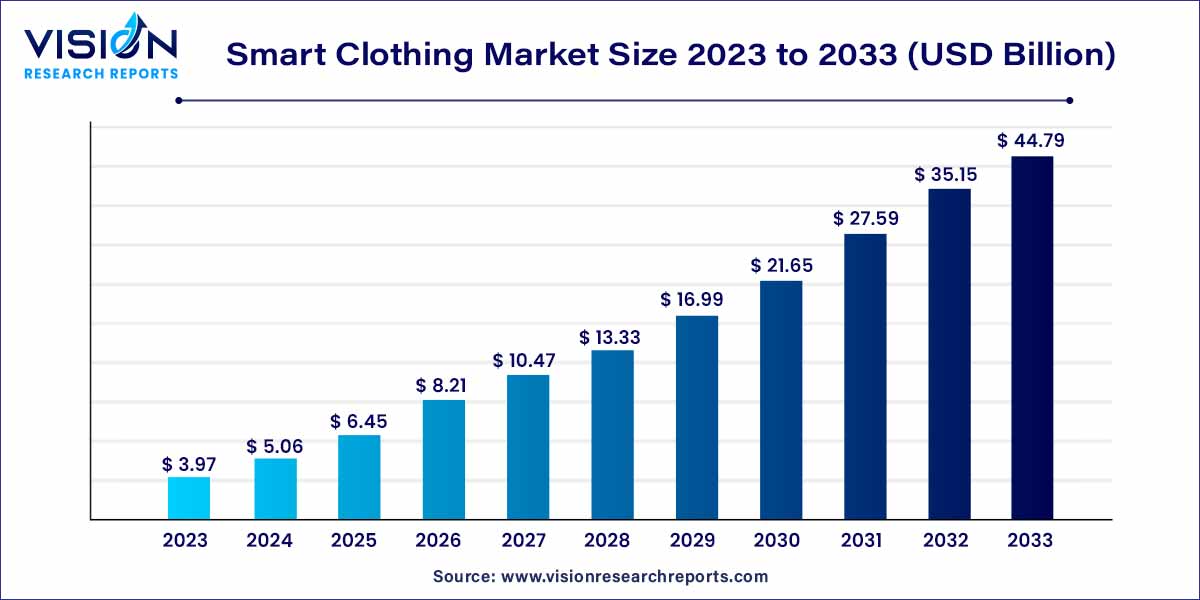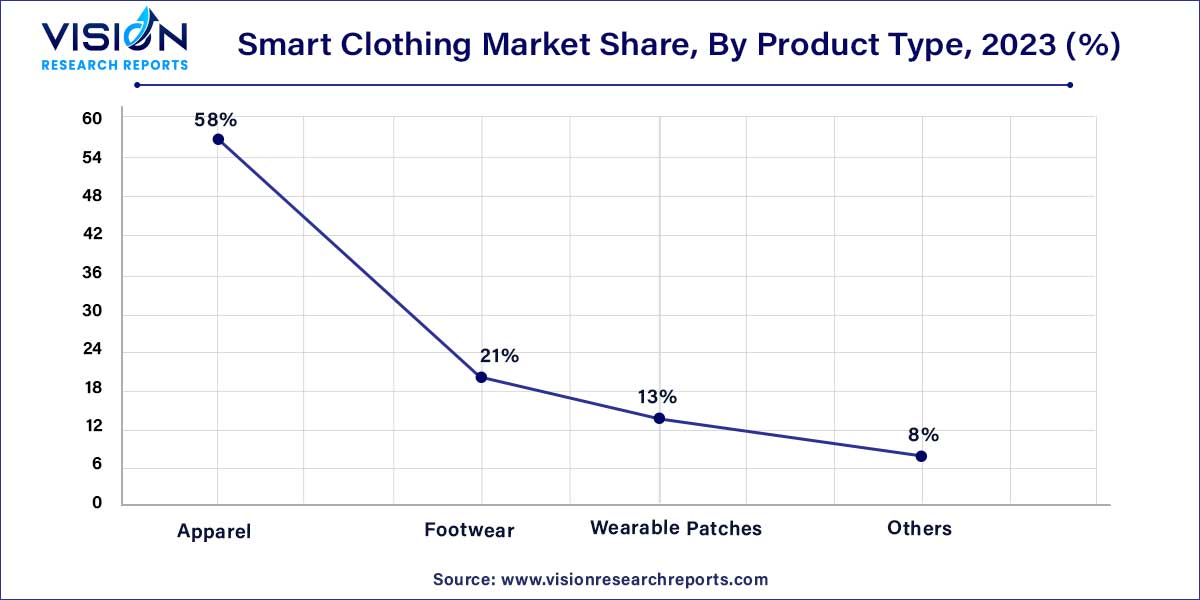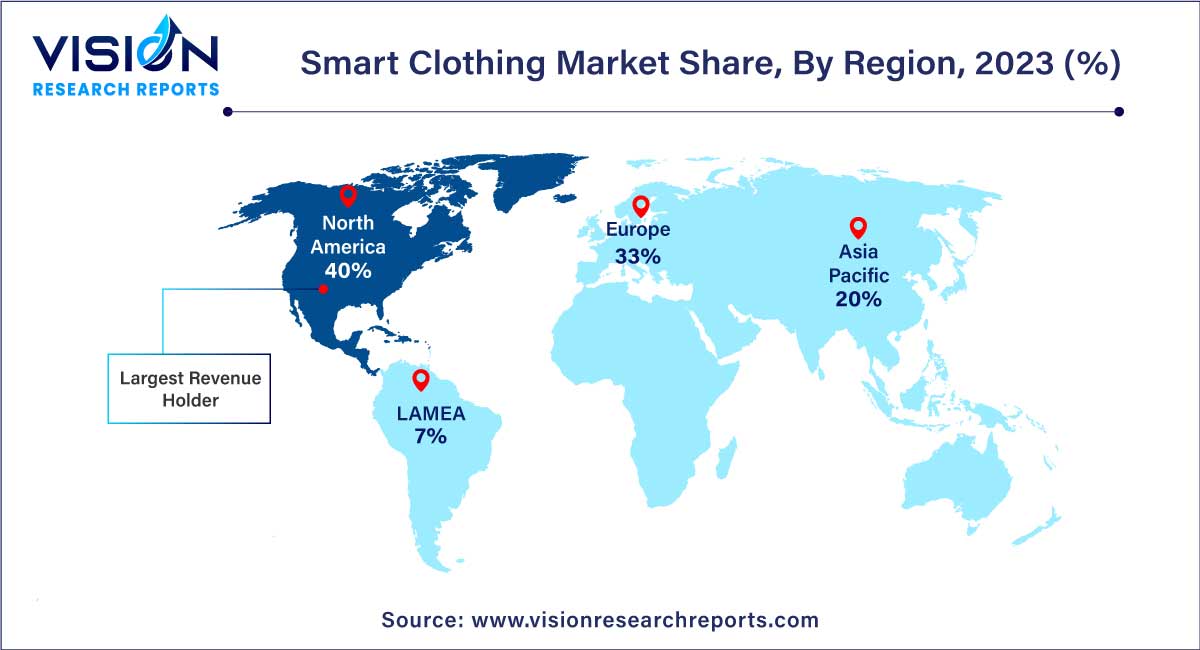The global smart clothing market size was estimated at around USD 3.97 billion in 2023 and it is projected to hit around USD 44.79 billion by 2033, growing at a CAGR of 27.42% from 2024 to 2033.

The smart clothing market has witnessed a substantial evolution in recent years, driven by advancements in technology and a growing demand for innovative wearables. This overview aims to shed light on the key aspects of the smart clothing industry, including current trends, technological innovations, and factors contributing to its growth.
The Smart Clothing market is experiencing notable growth driven by several key factors. Increased awareness and widespread adoption of wearable technology among consumers have played a pivotal role in fueling this expansion. The rising demand for personalized and connected experiences has further propelled the market, with smart clothing offering users innovative functionalities beyond conventional apparel. Advancements in material science have contributed to the development of more comfortable and durable smart textiles, enhancing the overall appeal of these products. Additionally, the expansion of applications across diverse industry verticals, from sports and fitness to healthcare and fashion, has broadened the market's reach. As a result, the convergence of technology and apparel continues to drive the growth of the Smart Clothing market, with ongoing innovations expected to shape its trajectory in the coming years.
| Report Coverage | Details |
| Growth Rate from 2024 to 2033 | CAGR of 27.42% |
| Market Revenue by 2033 | USD 44.79 billion |
| Revenue Share of North America in 2023 | 40% |
| Base Year | 2023 |
| Forecast Period | 2023 to 2032 |
| Market Analysis (Terms Used) | Value (US$ Million/Billion) or (Volume/Units) |
In 2023, the active smart textile segment dominated the market with the market share of 43%. This supremacy can be attributed to the remarkable capability of active smart textiles to sense and respond to stimuli, making them highly versatile across various industries. Notably, the incorporation of phase-change materials enables efficient heat storage and transfer, leading to applications in specialized outfits for sports, firefighting, and defense. The integration of these textiles not only enhances the comfort of products but also allows them to adapt to environmental conditions. Consequently, the demand for active smart textiles has witnessed notable growth, driven by the need for innovative solutions that bring adaptability and functionality to textiles across diverse sectors.
The ultra-smart textile segment is poised for significant growth between 2023 and 2032. Distinguished as third-generation smart textiles, ultra-smart textiles possess the unique ability to sense, respond, and adjust to environmental conditions. Functioning akin to a cognitive and reasoning brain, these garments feature an activation unit capable of emitting audible warnings and vibrations when, for example, the wearer reaches a specific heart rate level. This dynamic responsiveness highlights the advanced capabilities of ultra-smart textiles, designed to adapt their functions based on the specific needs of the wearer. The sophistication in monitoring, real-time data reaction, and adaptive functionality underscores the innovative nature of ultra-smart textiles, signifying a substantial advancement in the integration of intelligence and practicality within wearable technology.
The offline segment secured the largest share of revenue of 64% in 2023. Traditional retail channels, such as brick-and-mortar stores and physical outlets, exert a pivotal influence on consumer purchasing behavior. The allure of in-person shopping remains compelling for many consumers who value the opportunity to physically interact with and try on smart clothing items before making a purchase. Additionally, offline distribution channels serve as an immediate and accessible avenue for consumers to explore and acquire products, a critical aspect in the smart clothing market where concerns about technology, features, and compatibility often arise.
Forecasts indicate substantial growth for the online segment in the upcoming period. The increasing prevalence of e-commerce platforms and the escalating trend of online shopping have significantly propelled the dominance of this segment. The expansive array of choices on online platforms, coupled with user reviews and ratings, enriches the decision-making process for consumers seeking smart clothing. Furthermore, online channels frequently present competitive pricing, discounts, and promotions, appealing to a broad and diverse customer base. The online landscape is poised for considerable expansion, reflecting the evolving preferences of consumers and the convenience offered by digital retail experiences.
Military & Defense Segment Leads with Over 27% Revenue Share in 2023. The integration of smart clothing in military applications plays a crucial role in advancing combat gear, incorporating intelligent uniforms, helmets, and protective wear. These technologies provide functionalities such as real-time monitoring of vital signs, GPS tracking, and communication capabilities, markedly enhancing the effectiveness and safety of military operations. Furthermore, substantial investments in research and development within the defense sector propel the integration of cutting-edge technologies into smart clothing, establishing it as an indispensable element of contemporary military equipment.
The sports & fitness segment is poised for significant growth from 2023 to 2032. Sensors have already found application in various clothing lines and undergarments, including sports bras equipped with heart rate monitoring capabilities and heated underwear. Within the sports and fitness industry, there is a notable uptick in the demand for smart innerwear, driven by the widespread adoption of sports bras featuring sensors capable of recording metrics such as running distance, breathing rate, and heart rate. The integration of sensor technology into innerwear caters to the evolving needs of athletes and fitness enthusiasts, positioning this market segment for considerable expansion throughout the forecast period.
Apparel Segment Dominates with Over 58% Revenue Share in 2023. The increasing preference for smart shirts, jackets, and vests is driving the growth of this segment. Smart apparel provides vital biometric data, including heart rate, breathing rate, and muscle activity, facilitating the professional optimization of performance and workout plans. This real-time data seamlessly transmits to partner apps, offering valuable insights into various sport-related metrics such as calories burned, intensity and recovery, fatigue levels, and sleep quality. The growing adoption of upper wear across various end-user applications is expected to create significant opportunities for smart clothing providers throughout the forecast period.

The footwear segment is poised for substantial growth from 2023 to 2032. The increasing integration of technology into footwear has transformed traditional shoes into intelligent, data-capturing devices. Smart footwear incorporates sensors and connectivity features that monitor various aspects, including step count, gait analysis, and even offer features like GPS tracking. Furthermore, the popularity of smart footwear is driven by the rising awareness of health and fitness, as these shoes provide users with valuable insights into their physical activities and help optimize workout routines. The incorporation of smart technologies in footwear enhances the overall user experience, making them not only functional but also fashionable.
In 2023, North America dominated the market with the largest market share of 40%. This leadership position can be attributed to the region's advancements in smart clothing technologies and the presence of key industry players, including Sensoria Inc., Ralph Lauren Media LLC, and Under Armour, Inc. The substantial growth is further driven by the escalating demand for smart clothing, particularly from the military sector. The military is actively embracing and customizing smart clothing technologies to develop battle-ready uniforms, providing a distinct advantage in the field. These uniforms, equipped with integrated sensors, measure crucial metrics such as muscle data, temperature, and heart and respiration rates, enabling comprehensive health assessments for soldiers.

For instance, in September 2023, the U.S. government unveiled a USD 22 million investment initiative named SMART ePANTS, dedicated to advancing smart surveillance clothing technology. The program aims to develop wearable garments capable of recording audio and video, tracking geolocation, and monitoring physiological data. These high-tech garments are intended for intelligence agencies and military personnel in high-risk environments, enhancing situational awareness and data collection capabilities.
Asia Pacific is anticipated to register the fastest CAGR from 2024 to 2032. Many leading technology and textile manufacturing companies in countries like China, Japan, and South Korea are involved in producing smart clothing. It includes integrating advanced sensors, fabrics, and electronic components into garments. Moreover, the region has a large and tech-savvy consumer base. The growing urban population and increasing awareness of health and fitness, has driven the demand for smart clothing. Additionally, the region is known for its rapid adoption of new technologies, creating a conducive environment for market growth.
By Textile Type
By Product Type
By Distribution Channel
By End-user
By Region
Chapter 1. Introduction
1.1. Research Objective
1.2. Scope of the Study
1.3. Definition
Chapter 2. Research Methodology
2.1. Research Approach
2.2. Data Sources
2.3. Assumptions & Limitations
Chapter 3. Executive Summary
3.1. Market Snapshot
Chapter 4. Market Variables and Scope
4.1. Introduction
4.2. Market Classification and Scope
4.3. Industry Value Chain Analysis
4.3.1. Raw Material Procurement Analysis
4.3.2. Sales and Distribution Channel Analysis
4.3.3. Downstream Buyer Analysis
Chapter 5. COVID 19 Impact on Smart Clothing Market
5.1. COVID-19 Landscape: Smart Clothing Industry Impact
5.2. COVID 19 - Impact Assessment for the Industry
5.3. COVID 19 Impact: Global Major Government Policy
5.4. Market Trends and Opportunities in the COVID-19 Landscape
Chapter 6. Market Dynamics Analysis and Trends
6.1. Market Dynamics
6.1.1. Market Drivers
6.1.2. Market Restraints
6.1.3. Market Opportunities
6.2. Porter’s Five Forces Analysis
6.2.1. Bargaining power of suppliers
6.2.2. Bargaining power of buyers
6.2.3. Threat of substitute
6.2.4. Threat of new entrants
6.2.5. Degree of competition
Chapter 7. Competitive Landscape
7.1.1. Company Market Share/Positioning Analysis
7.1.2. Key Strategies Adopted by Players
7.1.3. Vendor Landscape
7.1.3.1. List of Suppliers
7.1.3.2. List of Buyers
Chapter 8. Global Smart Clothing Market, By Textile Type
8.1. Smart Clothing Market, by Textile Type, 2024-2033
8.1.1. Active Smart
8.1.1.1. Market Revenue and Forecast (2021-2033)
8.1.2. Passive Smart
8.1.2.1. Market Revenue and Forecast (2021-2033)
8.1.3. Ultra Smart
8.1.3.1. Market Revenue and Forecast (2021-2033)
Chapter 9. Global Smart Clothing Market, By Product Type
9.1. Smart Clothing Market, by Product Type, 2024-2033
9.1.1. Apparel
9.1.1.1. Market Revenue and Forecast (2021-2033)
9.1.2. Footwear
9.1.2.1. Market Revenue and Forecast (2021-2033)
9.1.3. Wearable Patches
9.1.3.1. Market Revenue and Forecast (2021-2033)
9.1.4. Others
9.1.4.1. Market Revenue and Forecast (2021-2033)
Chapter 10. Global Smart Clothing Market, By Distribution Channel
10.1. Smart Clothing Market, by Distribution Channel, 2024-2033
10.1.1. Offline
10.1.1.1. Market Revenue and Forecast (2021-2033)
10.1.2. Online
10.1.2.1. Market Revenue and Forecast (2021-2033)
Chapter 11. Global Smart Clothing Market, By End-user
11.1. Smart Clothing Market, by End-user, 2024-2033
11.1.1. Military & Defense
11.1.1.1. Market Revenue and Forecast (2021-2033)
11.1.2. Sports & Fitness
11.1.2.1. Market Revenue and Forecast (2021-2033)
11.1.3. Fashion & Entertainment
11.1.3.1. Market Revenue and Forecast (2021-2033)
11.1.4. Healthcare
11.1.4.1. Market Revenue and Forecast (2021-2033)
11.1.5. Mining
11.1.5.1. Market Revenue and Forecast (2021-2033)
Chapter 12. Global Smart Clothing Market, Regional Estimates and Trend Forecast
12.1. North America
12.1.1. Market Revenue and Forecast, by Textile Type (2021-2033)
12.1.2. Market Revenue and Forecast, by Product Type (2021-2033)
12.1.3. Market Revenue and Forecast, by Distribution Channel (2021-2033)
12.1.4. Market Revenue and Forecast, by End-user (2021-2033)
12.1.5. U.S.
12.1.5.1. Market Revenue and Forecast, by Textile Type (2021-2033)
12.1.5.2. Market Revenue and Forecast, by Product Type (2021-2033)
12.1.5.3. Market Revenue and Forecast, by Distribution Channel (2021-2033)
12.1.5.4. Market Revenue and Forecast, by End-user (2021-2033)
12.1.6. Rest of North America
12.1.6.1. Market Revenue and Forecast, by Textile Type (2021-2033)
12.1.6.2. Market Revenue and Forecast, by Product Type (2021-2033)
12.1.6.3. Market Revenue and Forecast, by Distribution Channel (2021-2033)
12.1.6.4. Market Revenue and Forecast, by End-user (2021-2033)
12.2. Europe
12.2.1. Market Revenue and Forecast, by Textile Type (2021-2033)
12.2.2. Market Revenue and Forecast, by Product Type (2021-2033)
12.2.3. Market Revenue and Forecast, by Distribution Channel (2021-2033)
12.2.4. Market Revenue and Forecast, by End-user (2021-2033)
12.2.5. UK
12.2.5.1. Market Revenue and Forecast, by Textile Type (2021-2033)
12.2.5.2. Market Revenue and Forecast, by Product Type (2021-2033)
12.2.5.3. Market Revenue and Forecast, by Distribution Channel (2021-2033)
12.2.5.4. Market Revenue and Forecast, by End-user (2021-2033)
12.2.6. Germany
12.2.6.1. Market Revenue and Forecast, by Textile Type (2021-2033)
12.2.6.2. Market Revenue and Forecast, by Product Type (2021-2033)
12.2.6.3. Market Revenue and Forecast, by Distribution Channel (2021-2033)
12.2.6.4. Market Revenue and Forecast, by End-user (2021-2033)
12.2.7. France
12.2.7.1. Market Revenue and Forecast, by Textile Type (2021-2033)
12.2.7.2. Market Revenue and Forecast, by Product Type (2021-2033)
12.2.7.3. Market Revenue and Forecast, by Distribution Channel (2021-2033)
12.2.7.4. Market Revenue and Forecast, by End-user (2021-2033)
12.2.8. Rest of Europe
12.2.8.1. Market Revenue and Forecast, by Textile Type (2021-2033)
12.2.8.2. Market Revenue and Forecast, by Product Type (2021-2033)
12.2.8.3. Market Revenue and Forecast, by Distribution Channel (2021-2033)
12.2.8.4. Market Revenue and Forecast, by End-user (2021-2033)
12.3. APAC
12.3.1. Market Revenue and Forecast, by Textile Type (2021-2033)
12.3.2. Market Revenue and Forecast, by Product Type (2021-2033)
12.3.3. Market Revenue and Forecast, by Distribution Channel (2021-2033)
12.3.4. Market Revenue and Forecast, by End-user (2021-2033)
12.3.5. India
12.3.5.1. Market Revenue and Forecast, by Textile Type (2021-2033)
12.3.5.2. Market Revenue and Forecast, by Product Type (2021-2033)
12.3.5.3. Market Revenue and Forecast, by Distribution Channel (2021-2033)
12.3.5.4. Market Revenue and Forecast, by End-user (2021-2033)
12.3.6. China
12.3.6.1. Market Revenue and Forecast, by Textile Type (2021-2033)
12.3.6.2. Market Revenue and Forecast, by Product Type (2021-2033)
12.3.6.3. Market Revenue and Forecast, by Distribution Channel (2021-2033)
12.3.6.4. Market Revenue and Forecast, by End-user (2021-2033)
12.3.7. Japan
12.3.7.1. Market Revenue and Forecast, by Textile Type (2021-2033)
12.3.7.2. Market Revenue and Forecast, by Product Type (2021-2033)
12.3.7.3. Market Revenue and Forecast, by Distribution Channel (2021-2033)
12.3.7.4. Market Revenue and Forecast, by End-user (2021-2033)
12.3.8. Rest of APAC
12.3.8.1. Market Revenue and Forecast, by Textile Type (2021-2033)
12.3.8.2. Market Revenue and Forecast, by Product Type (2021-2033)
12.3.8.3. Market Revenue and Forecast, by Distribution Channel (2021-2033)
12.3.8.4. Market Revenue and Forecast, by End-user (2021-2033)
12.4. MEA
12.4.1. Market Revenue and Forecast, by Textile Type (2021-2033)
12.4.2. Market Revenue and Forecast, by Product Type (2021-2033)
12.4.3. Market Revenue and Forecast, by Distribution Channel (2021-2033)
12.4.4. Market Revenue and Forecast, by End-user (2021-2033)
12.4.5. GCC
12.4.5.1. Market Revenue and Forecast, by Textile Type (2021-2033)
12.4.5.2. Market Revenue and Forecast, by Product Type (2021-2033)
12.4.5.3. Market Revenue and Forecast, by Distribution Channel (2021-2033)
12.4.5.4. Market Revenue and Forecast, by End-user (2021-2033)
12.4.6. North Africa
12.4.6.1. Market Revenue and Forecast, by Textile Type (2021-2033)
12.4.6.2. Market Revenue and Forecast, by Product Type (2021-2033)
12.4.6.3. Market Revenue and Forecast, by Distribution Channel (2021-2033)
12.4.6.4. Market Revenue and Forecast, by End-user (2021-2033)
12.4.7. South Africa
12.4.7.1. Market Revenue and Forecast, by Textile Type (2021-2033)
12.4.7.2. Market Revenue and Forecast, by Product Type (2021-2033)
12.4.7.3. Market Revenue and Forecast, by Distribution Channel (2021-2033)
12.4.7.4. Market Revenue and Forecast, by End-user (2021-2033)
12.4.8. Rest of MEA
12.4.8.1. Market Revenue and Forecast, by Textile Type (2021-2033)
12.4.8.2. Market Revenue and Forecast, by Product Type (2021-2033)
12.4.8.3. Market Revenue and Forecast, by Distribution Channel (2021-2033)
12.4.8.4. Market Revenue and Forecast, by End-user (2021-2033)
12.5. Latin America
12.5.1. Market Revenue and Forecast, by Textile Type (2021-2033)
12.5.2. Market Revenue and Forecast, by Product Type (2021-2033)
12.5.3. Market Revenue and Forecast, by Distribution Channel (2021-2033)
12.5.4. Market Revenue and Forecast, by End-user (2021-2033)
12.5.5. Brazil
12.5.5.1. Market Revenue and Forecast, by Textile Type (2021-2033)
12.5.5.2. Market Revenue and Forecast, by Product Type (2021-2033)
12.5.5.3. Market Revenue and Forecast, by Distribution Channel (2021-2033)
12.5.5.4. Market Revenue and Forecast, by End-user (2021-2033)
12.5.6. Rest of LATAM
12.5.6.1. Market Revenue and Forecast, by Textile Type (2021-2033)
12.5.6.2. Market Revenue and Forecast, by Product Type (2021-2033)
12.5.6.3. Market Revenue and Forecast, by Distribution Channel (2021-2033)
12.5.6.4. Market Revenue and Forecast, by End-user (2021-2033)
Chapter 13. Company Profiles
13.1. AiQ Smart Clothing
13.1.1. Company Overview
13.1.2. Product Offerings
13.1.3. Financial Performance
13.1.4. Recent Initiatives
13.2. Sensoria, Inc.
13.2.1. Company Overview
13.2.2. Product Offerings
13.2.3. Financial Performance
13.2.4. Recent Initiatives
13.3. Vulpés Electronics GmbH
13.3.1. Company Overview
13.3.2. Product Offerings
13.3.3. Financial Performance
13.3.4. Recent Initiatives
13.4. DuPont de Nemours, Inc.
13.4.1. Company Overview
13.4.2. Product Offerings
13.4.3. Financial Performance
13.4.4. Recent Initiatives
13.5. WEARABLE X.
13.5.1. Company Overview
13.5.2. Product Offerings
13.5.3. Financial Performance
13.5.4. Recent Initiatives
13.6. TORAY INDUSTRIES, INC.
13.6.1. Company Overview
13.6.2. Product Offerings
13.6.3. Financial Performance
13.6.4. Recent Initiatives
13.7. Myontec
13.7.1. Company Overview
13.7.2. Product Offerings
13.7.3. Financial Performance
13.7.4. Recent Initiatives
13.8. Myzone Limited
13.8.1. Company Overview
13.8.2. Product Offerings
13.8.3. Financial Performance
13.8.4. Recent Initiatives
13.9. Siren Care, Inc.
13.9.1. Company Overview
13.9.2. Product Offerings
13.9.3. Financial Performance
13.9.4. Recent Initiatives
13.10. Owlet Baby Care, Inc.
13.10.1. Company Overview
13.10.2. Product Offerings
13.10.3. Financial Performance
13.10.4. Recent Initiatives
Chapter 14. Research Methodology
14.1. Primary Research
14.2. Secondary Research
14.3. Assumptions
Chapter 15. Appendix
15.1. About Us
15.2. Glossary of Terms
 Cross-segment Market Size and Analysis for
Mentioned Segments
Cross-segment Market Size and Analysis for
Mentioned Segments
 Additional Company Profiles (Upto 5 With No Cost)
Additional Company Profiles (Upto 5 With No Cost)
 Additional Countries (Apart From Mentioned Countries)
Additional Countries (Apart From Mentioned Countries)
 Country/Region-specific Report
Country/Region-specific Report
 Go To Market Strategy
Go To Market Strategy
 Region Specific Market Dynamics
Region Specific Market Dynamics Region Level Market Share
Region Level Market Share Import Export Analysis
Import Export Analysis Production Analysis
Production Analysis Others
Others